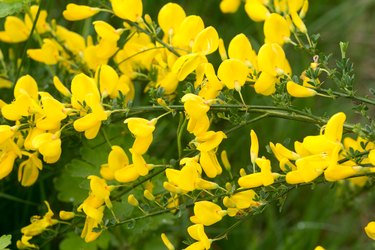
If there were a "ten most wanted" list for noxious, invasive plants, Scotch broom's (Cytisus scoparius) picture would top the list. While meadows, forest clearings and roadsides burst with the yellow-flowered bushes, adding luster to the panorama, the Scotch broom is quietly spreading its toxicity and upsetting the biodiversity of its geography. The U.S. Department of Agriculture hardiness zones 5-8 are the best growing grounds for Scotch Broom, which was imported from Europe in the 1850s and planted in gardens and along roadsides for erosion control. If you decide that your landscape benefits from this invasive, but attractive, bush, pruning a Scotch broom bush controls its prolific seed-producing cycle and keeps growth in check.
Recognizing Types of Scotch Broom Plants
Video of the Day
In North America, two different types of Scotch Broom are present and they are distinguished by their flower color. The Cytisus scoparius v. scoparius flowers are bright yellow, and the Cytisus scoparius v andreanus has dark red and yellow flowers. The andreanus variety is found only in California, according to the U.S. Department of Agriculture. Both species are classified as noxious weeds. However, more varieties are being created as the plant is becoming popular in domestic gardens since it does well in poor, sandy soils.
Video of the Day
The Scotch Broom can form very dense stands that are practically impenetrable and are attractive to pollinators such as bees. But they are also fire hazards. When the seeds are mature, their pods explode as they open, and the seeds are spread up to 20 feet in every direction. Pruning a domestic Scotch Broom can control the seed spread; however, the Scotch Broom banks its seeds in the soil, and they can be viable for up to 60 years.
Caring for and Controlling Scotch Broom
If your soil is heavy and compacted, Scotch Broom will thrive. It's not fussy as to the soil composition. The important note for the home gardener is to keep this invasive plant under control. Pruning is essential and unlike pruning for most shrubs, the Scotch Broom bush flowers in the spring and is pruned after flowering has occurred. The key to pruning is to do it after seed dispersal.
Thinning out the branches allows sun to reach the center of the bush. Cut back at least 1/3 of the older branches to the base of the plant and as the branches fall, look for pests. If the base of the plant is greater than 1-inch or if the Scotch Broom is drought-stressed, deep-cut before the seeds mature. This is the most effective method of mature broom control. It also gives you a better opportunity to shape your shrub.
Buy a Goat
Goats love Scotch Broom and are excellent for controlling the plant's growth and spread. Seed-feeding beetles also help reduce seed production, both according to the San Juan County Noxious Weed Control Program. But if livestock and insects aren't in your wheelhouse, keep your Scotch Broom well-trimmed, in full sun and the stems cut short after flowering. And above all, control the seed spread and watch for unwanted seedlings popping up elsewhere in your landscape.
- National Park Service: Exotic Species: Scotch Broom
- U.S. Department of Agriculture: Fire Effects Information System: Cytisus scoparius, C. striatus
- NC State University: Cytisus Scoparius
- Conservation Garden Park: Moonlight Scotch Broom
- San Juan County Noxious Weed Control Program: Scotch (Scot’s) Broom